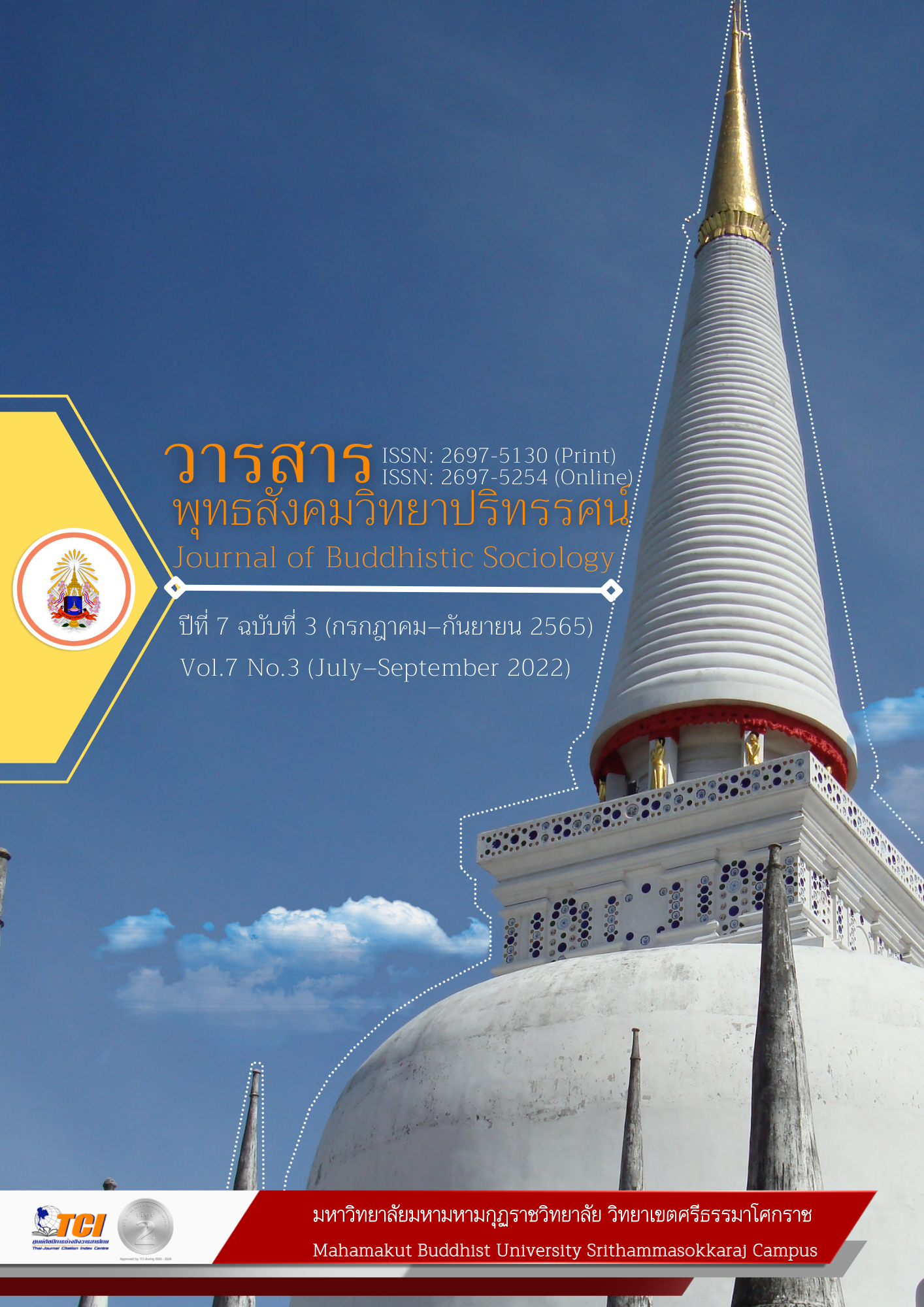PHYSICAL EXERCISE GUIDELINES APPROPRIATE FOR MONKS IN CHACHOENGSAO PROVINCE
Main Article Content
Abstract
This research aimed to 1) study the physical exercising behaviors of monks in Chachoengsao Province, 2) the opinions about the physical exercise of monks in Chachoengsao Province, and 3) the physical exercise guidelines appropriate for monks in Chachoengsao Province. This descriptive research sample group consisted of 346 monks in Chachoengsao Province, selected by the population ratio sampling method. The key informants were three Buddhist ecclesiastical official monks, two monks, and eight medical officials, 13 informants in total.
A focus group discussion of 9 representatives selected by purposive sampling was provided. The research instruments were 1) a questionnaire, 2) an interview form, and 3) a focus group discussion form. Data were analyzed using fundamental statistics: frequency, percentage, mean, and standard deviation. Content analysis and descriptive writing were employed for the qualitative research section.
The research showed that;
1. Overall, monks' physical exercise behaviors in Chachoengsao Province were at a good level.
2. Overall, opinions on the physical exercise of monks in Chachoengsao Province were at a high level.
3. Physical exercise guidelines appropriate for monks in Chachoengsao Province showed that monks could exercise their bodies using the Chakra 4: adjusting the four postures-stand, walk, sit, and lie down to balance the body. The recommendations were as follows: 1) the monks should exercise the body appropriate to their ages and physical conditions, 2) they should exercise the body regularly at least three days a week for 30 minutes each, 3) they should exercise the body during the time they are not hungry or too full. If they have already eaten, they should wait at least two hours after meals, 4) they should not exercise in a sweltering or sunny place, and 5) they should not exercise when they feel tired or unwell.
Article Details

This work is licensed under a Creative Commons Attribution-NonCommercial-NoDerivatives 4.0 International License.
References
กรมอนามัย กระทรวงสาธารณสุข. (2563). สรุปโครงการดำเนินงาน จำแนกตามโครงการ/กิจกรรมสำคัญปีงบประมาณ 2563. เรียกใช้เมื่อ 15 เมษายน 2563 จาก http://doc.anamai.moph.go.th/?r=str- project/listbyproject&pid=S2563P135
เกศรา สว่างวงศ์. (2561). พฤติกรรมสุขภาพ 4 มิติ ของพระสงฆ์ในเขตปกครอง คณะสงฆ์ภาค 6. ใน รายงานการวิจัย. วิทยาลัยสงฆ์นครลำปาง มหาวิทยาลัยมหาจุฬาลงกรณราชวิทยาลัย.
เจตนิพัทธ์ พิธิยานุวัฒน์ และคณะ. (2563). พฤติกรรมการสร้างเสริมสุขภาพของพระสงฆ์ในอำเภอเมืองฉะเชิงเทรา จังหวัดฉะเชิงเทรา. ใน รายงานการวิจัย. วิทยาลัยสงฆ์พุทธโสธร มหาวิทยาลัยมหาจุฬาลงกรณราชวิทยาลัย.
เตชภณ ทองเติม และจีรนันท์ แก้วมา. (2562). กิจกรรมทางกายของพระภิกษุสูงวัยในจังหวัดศรีสะเกษ. วารสารศิลปศาสตร์ มหาวิทยาลัยแม่โจ้, 7(2), 49.
พรหมินทร์ เมธากาญจนศักดิ์ และคณะ. (2549). พฤติกรรมการออกกำลังกายเพื่อสุขภาพของนักศึกษา วิทยาเขตหนองคาย มหาวิทยาลัยขอนแก่น. ใน รายงานการวิจัย. วิทยาเขตหนองคาย มหาวิทยาลัยขอนแก่น.
วีรสิทธ หลงเจริญ. (2557). พฤติกรรมสุขภาพของพระสงฆ์ในเขตอำเภอเมืองจันทบุรี. ใน งานนิพนธ์ หลักสูตรรัฐประศาสนศาสตรมหาบัณฑิต สาขาวิชาการจัดการภาครัฐและภาคเอกชน. วิทยาลัยการบริหารรัฐกิจ มหาวิทยาลัยบูรพา.
อภิรักษ์ คำเสนาะ. (2549). การครองชีวิตเพื่อการส่งเสริมสุขภาพของพระสงฆ์ในอำเภอเมืองอุบลราชธานี. เชียงใหม่: มหาวิทยาลัยเชียงใหม่.
อารมณ์ สนานภู่ และคณะ. (2548). การวิจัยและพัฒนาการส่งเสริมการเล่นกีฬาและการออกกำลังกายเพื่อสุขภาพ 76 จังหวัด. ใน รายงานการวิจัย. มหาวิทยาลัยราชภัฏหมู่บ้านจอมบึง.
Adamu et al. (2006). Physicalexercise and health: areview. Nigerian journal of medicine, 15(3), 190.
Eyler et al. (1998). Physical Activity and Minority Women: A Qualitative Study. Health Education & Behavior, 25(5), 640-652.
Hong et al. (2008). Factors affecting exercise attendance and completion in sedentary older adults: a meta-analytic approach. J Phys Act Health, 5(3), 385-397.


